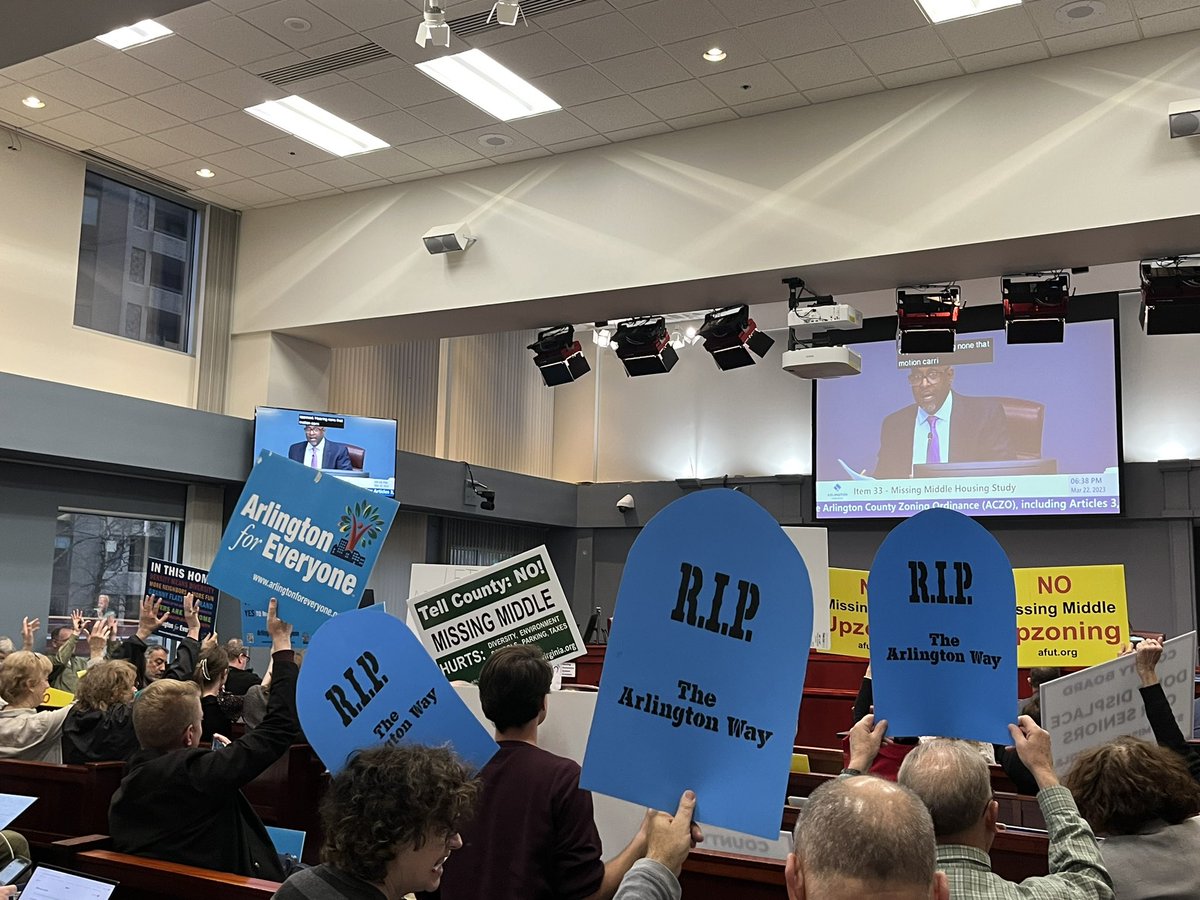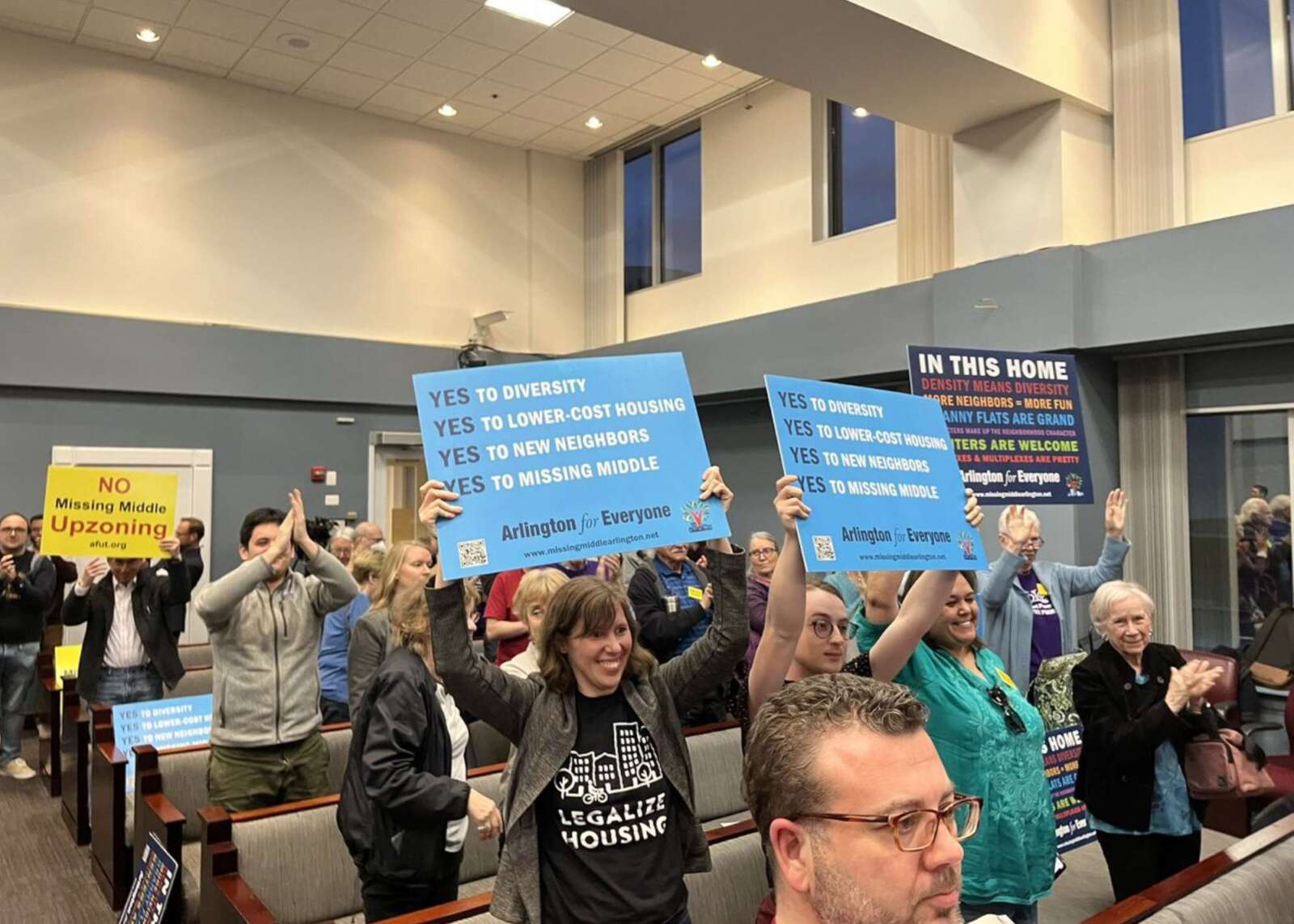(Updated at 11:10 a.m.) Last night, the Arlington County Board took a landmark step to allow the by-right development of 2-6 unit buildings throughout the county.
After the unanimous vote around 6:45 p.m., and additional statements by Board members, the room erupted in cheers from supporters, who shook hands and hugged and high-fived each other. There were, reportedly, a few teary eyes.
A slow trickle of opponents left the room as the meeting wore on, but many remained, swapping their yellow signs against upzoning for blue headstones mourning the burial of the “Arlington Way,” the name for the pathways citizens have for influencing policy-making.
Talk of a policy change like this dates back a decade and, for some Board members, was tied to tearful remembrances of conversations with the late County Board member, Erik Gutshall. After Amazon agreed to come to Arlington, the conversation picked up steam.
Arlington’s first step to increase housing stock was to allow accessory dwelling units. Its second step last night culminated more than two years of study that saw the proposal rebranded and modified to respond to some community concerns such as parking, tree canopy, and the pace of development.
There was lots of celebration on Twitter for the changes, which will go into effect on July 1 of this year.
Thank you @Matt4Arlington @TakisKarantonis @kcristol @libbygarvey @CD4arlington for moving @ArlingtonVA forward! This teacher appreciates this historic moment of righting historical wrongs. #MissingMiddle l pic.twitter.com/XwKErcPNI2
— #TiredTeacher (@pondfamily) March 22, 2023
tonight Arlington passed one of the most progressive zoning reforms in the nation—due in large part to the work of @NAACPArlington, @VOICEVirginia, @TheGattoniCelli and @janefgreen’s YIMBYs of NoVA and many others 👏 https://t.co/ZwWDaukIxk
— dan reed 🦀🏳️🌈👋🏾 (@justupthepike) March 22, 2023
Arlington’s County Board deserves credit for carrying a version of Missing Middle across the finish line.
A ton of that credit should also go to Jane and the NoVA YIMBYs, who organized an entire progressive housing movement from the ground-up. It’s a gargantuan accomplishment. https://t.co/1EvB8RSXpP
— Kevin Saucedo-Broach (@KSBforVA) March 22, 2023
A theme in the speeches County Board members made last night was that change is already here and county leaders have to respond to make sure the real estate market works for more people who want to live in Arlington.
In a statement from the advocacy group Virginians Organized for Interfaith Community Engagement (VOICE), member Pat Findikoglu echoed this sentiment, noting that the county is already changing, with larger, more expensive single-family homes replacing more modest homes.
“Change in the housing market is inevitable,” she said. “How we shape it to meet new needs and still remain livable is the challenge. VOICE believes this Expanded Housing Options proposal does that.”
Board members made a few more compromises, removing a clause that would allow for fewer parking for homes close to certain bus networks, plus approving a five-year cap of 58 units per year and a method of dispersing allowable units by zoning district.
YIMBYs of Northern Virginia co-founder Jane Fiegen Green accepted these limitations on social media but still heralded the decision as a win. She said the limitations could result in “less housing than otherwise.”
“Our organization is concerned that limitations imposed on the policy will yield fewer homes, without any practical or political benefit,” YIMBYs of Northern Virginia said in a statement. “Yet beyond the zoning changes that will help end racial segregation in the County and bring forth more housing, the Missing Middle campaign has shown our neighbors that restrictions on density and growth damage their community’s ability to be welcoming, inclusive and forward-looking.”
One group opposed to the plan did not acknowledge the concessions in its colorful post-mortem.
“This County Board has plopped a half-baked cake on the table that Arlington residents must now eat,” said Arlingtonians for Our Sustainable Future’s Peter Rousselot. “Arlington County is flying blind on Missing Middle, but it’s Arlington residents who now are headed for a crash landing.”
The vote “turns a page on the visionary transit-oriented development policy decisions of 50 years ago,” said Rousselot, who along with Green is a former ARLnow opinion columnist. He further alleged the policy-making will primarily be a boon for developers.
County Board candidate Susan Cunningham also said this departed from Arlington’s emphasis on transit-oriented “smart” growth. She represents a constituency that has staked out another “middle” position: broadly supportive of other efforts to increase the availability of attainable housing, just not last night’s changes.
“We needed to work together as one Arlington and create a common sense housing plan built on what we’ve already done and already proven: a solid track record of successful, smart growth,” she said in a statement on her website.
Debates over whether to allow the undergrounding of Metro and encourage development around these corridors featured strikingly similar talking points to Missing Middle.
“In just about every jurisdiction, including Arlington, you had some protests of some people, saying, ‘I like my neighborhood the way it is. I moved here because I like it the way it is. Please don’t change my neighborhood,’ Zachary Schrag, author of “The Great Society Subway,” said in a county-produced documentary about its smart growth planning.
Former County Board member Ellen Bozman, the namesake of the building where the change was approved, said people actively voiced their fears.
“They weren’t saying no growth,” she said in the documentary. “They were saying slow growth.”
It was not that opponents were against Metro said former planning commissioner Ted Weihe, who founded a local group called the Committee for Optimum Growth.
“The issue was how much development can Metro generate and is that beneficial,” he said.
Former county staff member Thomas C. Parker, Jr. said “that’s a dialogue that continues.”
Fifty years later, the county and proponents said allowing moderate density in current low-density neighborhoods would address the racial, socio-economic and environmental impacts of previous exclusionary housing practices, as well as help meet regional housing needs.
Opponents had none of this. They argued it would only yield expensive units, simultaneously lowering property values and pricing people of color out of neighborhoods, while contributing to tree loss. (The measure approved by the Board includes a requirement for having a certain number of shade trees on lots redeveloped as Missing Middle housing.)
This community debate was months-long, vigorous and at times times even caustic, introspective and divisive.
YIMBYs of Northern Virginia characterized critics as a “vitriolic, reactionary minority of Arlington homeowners.”
Arlingtonians for Upzoning Transparency (AFUT) lampooned proponents for “emotional, non-fact-based appeals for more attainable housing.”
AFUT instead highlighted the “testimony and data from experts including economists, realtors, mortgage bankers, engineers, and others showing that EHO will actually reduce diversity and not produce housing more affordable to anyone but upper income people with annual incomes approaching $200,000.”
“Those who think EHO will produce housing they can afford have been given false hope,” said AFUT representative David Gerk. “With today’s interest rates, even the cheapest, smallest unit in a six-plex will require an income of nearly $200,000 for a typical buyer.”
Gerk, in an email seen by ARLnow, predicted a lawsuit following the Board’s adoption of the zoning changes.
“I expect with near 100% certainty that a lawsuit to be filed in the next few weeks — stay tuned with afut.
The division in the community is reflected in the slate of County Board hopefuls, some of whom celebrated the decision while others are already planning for what’s next.
Candidates Julius “J.D.” Spain, Sr., the former president of the Arlington branch of the NAACP, and Jonathan Dromgoole praised the decision.
In 2020 @ArlingtonVA began its Missing Middle Housing Study to explore how new housing types could address shortfall's in housing supply. Tonight, we witnessed a rare moment in history by @CD4arlington @kcristol @TakisKarantonis @Matt4Arlington @libbygarvey
👏👏👏 pic.twitter.com/Sshmr2WKIQ— JD Spain Sr (@JDforArlington) March 23, 2023
This is a huge win for all Arlingtonians!
Missing middle will begin to end decades of exclusionary zoning practices & creates an inclusive way forward.
It's progress & gives many of us hope that we can call Arlington home and buy into that part of the American dream.
— Jonathan Dromgoole (@JonathanForVA) March 23, 2023
Roy, meanwhile, says Missing Middle may not be all that decided. She made part of her campaign platform putting Missing Middle housing on the ballot this November as an “advisory referendum question” to gauge community support.
“In a historic vote today, the Arlington County Board ignored the overwhelming majority of its tax paying residents to give a gift to developers” she said in a statement last night. “Sadly, the Board’s action will do nothing to help the many hardworking Arlingtonians who dream of home ownership. They will be squeezed even further out of the residential market by the Board’s shortsighted action.”
For Maureen Coffey, housing policy is just getting started.
Housing Justice requires a complete plan for how we will meet supply & affordability while keeping our quality of life!
We cannot let housing become mutually exclusive w/ preserving community & amenities.
That means getting serious about planning, transit, & YES trees too!!
— Maureen Coffey (she/her) (@maureencoffeyva) March 22, 2023
Tony Weaver did not have a statement on social media last night but his website lists his support for programs incentivizing construction of 2-4 plexes and “high-density townhome developments along transit corridors.”




